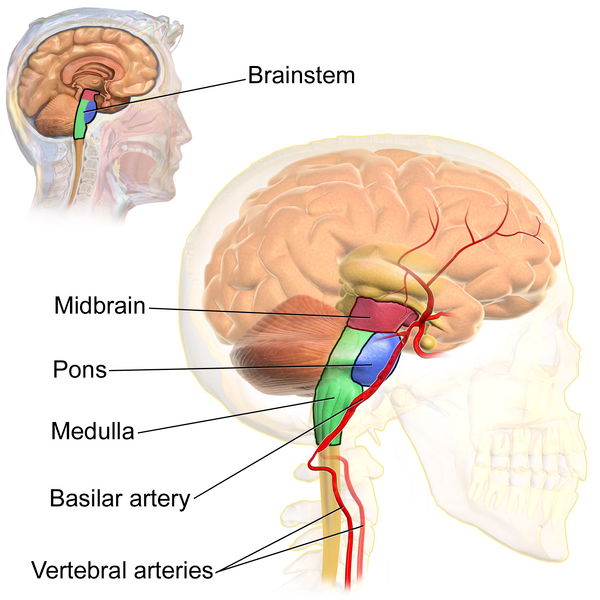11.4A: Functions of the Brain Stem
- Page ID
- 7619
The brainstem regulates vital cardiac and respiratory functions and acts as a vehicle for sensory information.
- Describe the functions of the brainstem
Key Points
- In vertebrate anatomy, the brainstem is the posterior part of the brain adjoining, and structurally continuous with, the spinal cord.
- Though small, the brainstem is an extremely important part of the brain, as the nerve connections from the motor and sensory systems of the cortex pass through it to communicate with the peripheral nervous system.
- The brainstem also plays an important role in the regulation of cardiac and respiratory function, consciousness, and the sleep cycle.
- The brainstem consists of the medulla oblongata, pons, and midbrain.
Key Terms
- pons: Contains nuclei that relay signals from the forebrain to the cerebellum, along with nuclei that deal primarily with sleep, respiration, swallowing, bladder control, hearing, equilibrium, taste, eye movement, facial expressions, facial sensation, and posture.
- midbrain: Associated with vision, hearing, motor control, sleep and wake cycles, alertness, and temperature regulation.
- medulla: The lower half of the brainstem that contains the cardiac, respiratory, vomiting, and vasomotor centers and regulates autonomic, involuntary functions such as breathing, heart rate, and blood pressure.
EXAMPLES
Diseases of the brainstem can result in abnormalities in cranial nerve function, leading to visual and hearing disturbances, changes in sensation, muscle weakness, vertigo, coordination problems, swallowing and speech difficulty, and voice changes.
Location and Basic Physiology
In vertebrate anatomy, the brainstem is the most inferior portion of the brain, adjoining and structurally continuous with the brain and spinal cord. The brainstem gives rise to cranial nerves 3 through 12 and provides the main motor and sensory innervation to the face and neck via the cranial nerves. Though small, it is an extremely important part of the brain, as the nerve connections of the motor and sensory systems from the main part of the brain that communicate with the peripheral nervous system pass through the brainstem. This includes the corticospinal tract (motor), the posterior column-medial lemniscus pathway (fine touch, vibration sensation, and proprioception ) and the spinothalamic tract ( pain, temperature, itch, and crude touch). The brain stem also plays an important role in the regulation of cardiac and respiratory function. It regulates the central nervous system (CNS) and is pivotal in maintaining consciousness and regulating the sleep cycle.
Components of the Brainstem
The three components of the brainstem are the medulla oblongata, midbrain, and pons.

Brainstem Anatomy: Structures of the brainstem are depicted on these diagrams, including the midbrain, pons, medulla, basilar artery, and vertebral arteries.
The medulla oblongata (myelencephalon) is the lower half of the brainstem continuous with the spinal cord. Its upper part is continuous with the pons. The medulla contains the cardiac, respiratory, vomiting, and vasomotor centers regulating heart rate, breathing, and blood pressure.
The midbrain (mesencephalon) is associated with vision, hearing, motor control, sleep and wake cycles, alertness, and temperature regulation.
The pons (part of metencephalon) lies between the medulla oblongata and the midbrain. It contains tracts that carry signals from the cerebrum to the medulla and to the cerebellum. It also has tracts that carry sensory signals to the thalamus.
Brainstem Function
The brainstem has many basic functions, including regulation of heart rate, breathing, sleeping, and eating. It also plays a role in conduction. All information relayed from the body to the cerebrum and cerebellum and vice versa must traverse the brainstem. The ascending pathways from the body to the brain are the sensory pathways, including the spinothalamic tract for pain and temperature sensation and the dorsal column, fasciculus gracilis, and cuneatus for touch, proprioception, and pressure sensation. The facial sensations have similar pathways and also travel in the spinothalamic tract and the medial lemniscus.
Descending tracts are upper motor neurons destined to synapse on lower motor neurons in the ventral horn and intermediate horn of the spinal cord. In addition, upper motor neurons originate in the brain stem’s vestibular, red, tectal, and reticular nuclei, which also descend and synapse in the spinal cord. The brainstem also has integrative functions, including cardiovascular system control, respiratory control, pain sensitivity control, alertness, awareness, and consciousness.
Human Brain with Cranial Nerves: Cranial nerves are nerves that emerge directly from the brain, in contrast to spinal nerves, which emerge from segments of the spinal cord. In humans, there are traditionally twelve pairs of cranial nerves. Only the first and the second pair emerge from the cerebrum; the remaining ten pairs emerge from the brainstem.

